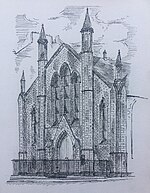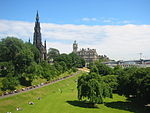St Cuthbert's Church, Edinburgh

The Parish Church of St Cuthbert is a parish church of the Church of Scotland in central Edinburgh. Probably founded in the 7th century, the church once covered an extensive parish around the burgh of Edinburgh. The church's current building was designed by Hippolyte Blanc and completed in 1894. St Cuthbert's is situated within a large churchyard that bounds Princes Street Gardens and Lothian Road. A church was probably founded on this site during or shortly after the life of Cuthbert. The church is first recorded in 1128, when David I granted it to Holyrood Abbey. At that time, the church covered an extensive parish, which was gradually reduced until the 20th century by the erection and expansion of other parishes, many of which were founded as chapels of ease of St Cuthbert's. St Cuthbert's became a Protestant church at the Scottish Reformation in 1560: from after the Reformation until the 19th century, the church was usually called the West Kirk. After the Restoration in 1660, the congregation remained loyal to the Covenanters. The church's position at the foot of Castle Rock saw it damaged or destroyed at least four times between the 14th and 17th centuries.The current church was built between 1892 and 1894 to replace a Georgian church, which had itself replaced a building of uncertain age. The building was designed by Hippolyte Blanc in the Baroque and Renaissance styles and retains the steeple of the previous church. The Buildings of Scotland guide to Edinburgh calls the church's furnishings "extraordinary". Features include stained glass windows by Louis Comfort Tiffany, Douglas Strachan, and Ballantyne & Gardiner; mural paintings by Gerald Moira and John Duncan; and memorials by John Flaxman and George Frampton. The church also possesses a ring of ten bells by Taylor of Loughborough. The church has been a Category A listed building since 1970.Seven of the church's ministers have served as Moderator of the General Assembly of the Church of Scotland during their incumbencies, including Robert Pont, who held the role on six occasions between the 1570s and 1590s. The church's present work includes ministries among homeless people and Edinburgh's business community.
Excerpt from the Wikipedia article St Cuthbert's Church, Edinburgh (License: CC BY-SA 3.0, Authors, Images).St Cuthbert's Church, Edinburgh
Lothian Road, City of Edinburgh Haymarket
Geographical coordinates (GPS) Address Phone number Website External links Nearby Places Show on map
Geographical coordinates (GPS)
| Latitude | Longitude |
|---|---|
| N 55.94965 ° | E -3.20505 ° |
Address
The Parish Church of St Cuthbert (St Cuthbert's Parish Church)
Lothian Road 5
EH1 2EP City of Edinburgh, Haymarket
Scotland, United Kingdom
Open on Google Maps











